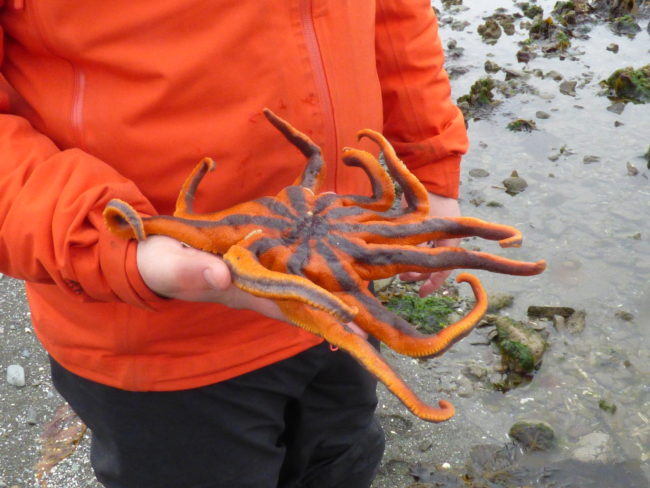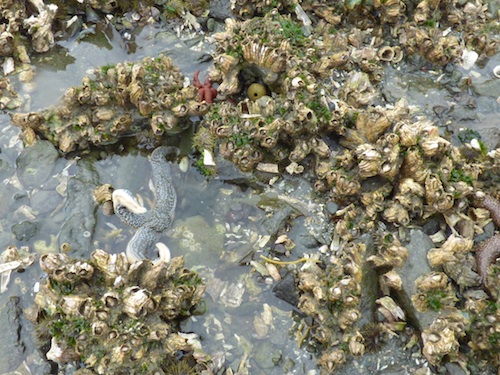
A mysterious virus that’s been wiping out sea stars on the West Coast since 2013 has spread all the way to Southeast Alaska — but it hasn’t made it to Southwest. That’s what a group of researchers found last month in Unalaska and Kodiak.
Now, they hope the islands’ healthy sea stars will give them new clues about how the virus works.
It’s low tide on a sandy beach outside Unalaska’s Captain’s Bay, and local scuba diver Josh Good is wading around in a rocky tide pool. It’s full of urchins, kelp and sponges. But Good is looking for something a little higher up the food chain.
He’s holding a 10-legged sea star, about a foot wide. It’s bright orange with purple stripes. The solaster eats sea cucumbers — but it can be food itself for bigger sea stars.
Further out, Good finds more stars of all different shapes and sizes. But there’s one thing they have in common — they’re healthy. And that’s big news, when stars up and down the West Coast and into Alaska have been dying off from sea star wasting disease.
Ian Hewson is a researcher at Cornell University. He visited Unalaska and Kodiak about a month ago, working with divers like Good to check if local sea stars were infected.
“We actually looked at about six different species of sea stars, and we collected samples from four of those and took them back to the lab,” Hewson says. “We can confirm that we didn’t detect the virus, which is normally associated with this disease further south.”

It’s been seen in Homer, Seward, Sitka, Juneau and Ketchikan. Huge numbers of stars develop lesions, lose limbs and finally disintegrate into mush.
Now, Hewson wants to know why that’s not happening in Southwest, and he’ll study samples from the healthy stars to find out. One theory, he says, is distance.
“There’s a big break in what’s known as biogeography of sea stars between Kodiak and, essentially, the Kenai Peninsula,” Hewson says. “It’s just a pretty deep stretch of water that not a lot of material goes between.”
That break could protect Unalaska and Kodiak, if the virus spreads how Hewson thinks it does — on juvenile sea stars. They’re spawned in the water, then float away from their parents and usually settle among new populations.
“So it’s almost as though, you know, you’ve got the daycare center, if you will,” Hewson says. “They’ve obviously got some pathogen out in the environment, and they’re bringing it home and infecting the adults.”
But the virus might not be all that’s causing the disease. In the Southwest samples, Hewson says he’ll be on the lookout for outside influences that could differ from infected areas.
“What we’re not terribly sure of is whether adverse environmental conditions makes it more susceptible to this virus, or whether, perhaps, it makes the symptoms more obvious to us,” he says. “So these are the types of questions that we are trying to work on.”
And it’s just the beginning of what they hope to do. If National Science Foundation funding comes through this summer, Hewson’s team will be back to the Southwest to collect entire stars.
They’ll quarantine them and infect them with the virus down South, Hewson says, “and then perform some very crucial experiments in our work related to understanding how this disease progresses from a completely healthy to a wasted-away sea star.”
Understanding that process could be the key to a mystery that’s having a major impact on the ocean. Wasting disease affects almost all species of stars — but especially bigger ones. Hewson gives the 3 foot-wide sunflower star as an example.
“That becomes a really dominant, keystone carnivore in the ecosystem,” he says. “It’s like your great white shark for an invertebrate.”
It’s so high up on the food chain that it has a bigger effect on the ecosystem when it dies off.
“Things that they normally eat have become really, really abundant. And those things include things like urchins, for example,” Hewson says. “Urchins play this pretty big role in controlling the amount of algae on rocky substrates, but because they’re herbivores, they actually consume kelps and things. And so when you get these big booms of urchins, basically the kelps disappear.”
Back on the beach in Unalaska, Josh Good is looking at a healthy ecosystem — where sea stars are keeping the whole food chain in balance.
Good was happy to hear that Unalaska’s sea stars are safe from wasting disease for now, but he and other locals are still keep an eye out for signs of change. Good does it every week, underwater and in his kayak. In fact, he was setting out for a paddle as soon as he put his sea stars back where he found them.
